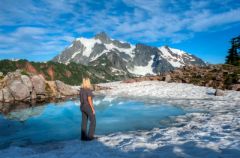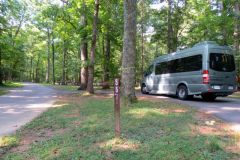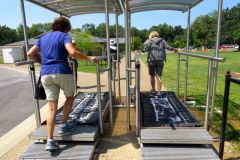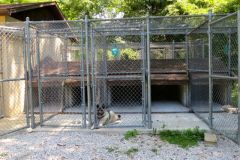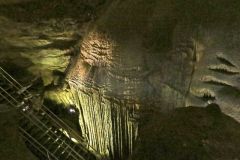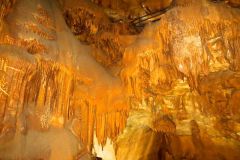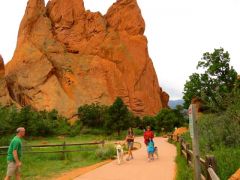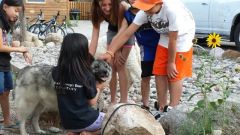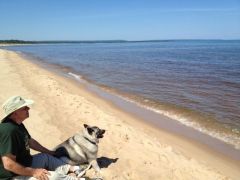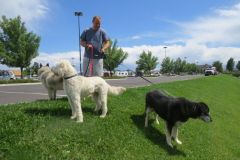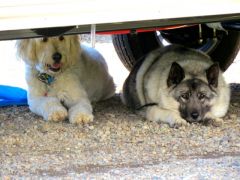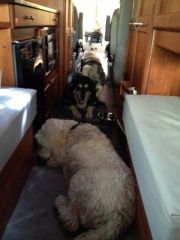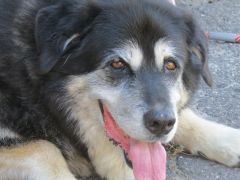-
Content Count
669 -
Joined
-
Last visited
-
Days Won
17
Content Type
Profiles
Forums
Blogs
Gallery
Everything posted by Roadtrekingmike
-
From the album: Meet Deby Dixon: Living the Dream as Yellowstone’s Storytell
Deby Dixon -
From the album: Meet Deby Dixon: Living the Dream as Yellowstone’s Storytell
Deby Dixon -
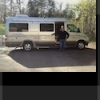
Meet Deby Dixon: Living the Dream as Yellowstone’s Storyteller
Roadtrekingmike posted a blog entry in Roadtreking Blog
Yellowstone National Park is a captivating place. It grabs the soul and pulls us back year after year. At the top of every RVers bucket list, it is a place so majestic, so wild and big that it calls us to return, to explore, to get to know the diversity of its land and animals over and over again. Some RVers make annual pilgrimages. Some volunteer as workers or hire on as temporary employees at the various concessions and park businesses. Anything to spend as much time there as possible. A few, a very fortunate few, live there. Deby Dixon is one of those who – while technically not really living in the park year round – comes about as close as possible. She lives in and keeps her RV – a travel trailer – just outside the park gates and spends weeks at a time camping in the park in a tent. When she’s not camping, she drives in most every day. Deby is a former police officer now turned wildlife journalist and photographer. Jennifer and I met her this summer at Yellowstone, our second visit in a year to the park. We were camping at the Pebble Creek campground and hanging out in our Roadtrek, with the sliding door open, waiting for a black bear that had been browsing in a meadow directly across from us to step into better view. Alas, the bear instead headed back into the trees. But then Deby passed by on her way out of the campground. She stopped, backed up and came over to check out our Roadtrek. Jennifer had met her earlier and so the two chatted. I gave a quick tour of the Roadtrek, which Deby thought would make a great vehicle for her. She was camping a few spaces over in her tent. She had been in that tent for close to a month. This was in early July. When we returned home, I looked her up and have been a fan of her work ever since. Debby, injured on the job as a law enforcement officer up in North Carolina, took up photography to illustrate articles she was writing for various publications on national parks. She loves all the national parks and has visited and photographed many. The photo above is a self portrait taken last year at Mt. Baker, looking toward Mt. Schuksan in North Cascades National Park where she worked as a photography volunteer. Her love of the national park wilderness and the animals that live there started after a month-long camping trip to Glacier, Yellowstone and Grand Teton national parks in 2009. The experience dramatically changed her life. “I no longer could stay home in the city,” she writes. ”I sold everything and moved into a 1970s model, 17-foot-travel trailer (since upgraded to a newer 21 foot trailer) and left on a journey to see the parks.” But since the fall of 2012, she’s been pretty much living at Yellowstone, writing about and photographing wildlife, especially the fragile wolf pack that hangs out in the Lamar Valley. She knows each wolf’s history, it’s parents and siblings and the story of its struggle to survive. You’ll learn all about that in our Q&A below. She keeps her travel trailer in Gardiner, at the park’s Northern entrances. Last winter, she rented an apartment there off season but made her way into the park every time she could all winter long. Since the snow melted, she’s spent a lot of time camping at Slough Creek or Pebble Creek, getting up most mornings at 4 AM and heading to her favorite vantage points in Lamar Valley in the northeast part of the park that is home to bison, black bears, grizzly bears, coyotes, badgers, otters, elk and wolves. She will typically stay out there till mid or late morning, return to camp to edit her photos, maybe answer some e-mail, work on her photography column for National Parks Traveler magazine and then update her Deby Dixon Photography Page and a new one, strictly about the Park, the Yellowstone Daily. By 5 PM or so, she’s back out in Lamar Valley, or wherever the animal action happens to be that day. Sometimes she will hike off to favorite spots to just sit and wait to see what animals show up. Often, she’s not back at camp until way after dark. Divorced, she has four grandchildren and two sons who live in Idaho. She travels and camps alone but has many friends at Yellowstone, fellow photographers and animal watchers. There’s a whole community of like-minded people who spend as much time as they can at the park. You’ll see them in the various pulloffs around the park’s perimeter roads, usually with spotting scopes. Most are equipped with their own two way business band radios that they use to share sightings and pass along tips about what animals are where. Deby is well respected by the other photographers, and park rangers as well, even though she has no official connection with the parks service. “She’s a great photographer and she’s driven by a genuine love of the animals and the park,” the Pebble Creek campground host told me. “Everyone around here looks up to her. She is very dedicated. Has to be to keep the hours she keeps taking her pictures.” Over the past couple of years, her almost daily stories and photos have captivated thousands who have discovered her animal advocacy journalism and wildlife photography. You, I am sure, will be among them once you check out the links to her Facebook Pages. Here’s my Q & A with Deby: Q: Why is Yellowstone so important to you? A: Because Yellowstone is a massive and diverse eco-system that has everything in nature that one could want – from the high peaks and sub-alpine meadows to the rocky desert sage. There are wide-open spaces, meadows and valleys and thick evergreen and conifer forests, along with lakes, streams and creeks. And then there is the scary mystery of the thermal features that constantly capture my imagination. I mean, if Yellowstone blows, I will be amongst the first to go as lava fields and plumes of ash spread. And then there is the wildlife, their lives, their interactions and their untimely deaths. For a wildlife/nature photographer who likes to write stories, Yellowstone has almost everything. Everything except the Tetons reflected in the Snake River, another favorite national park just to the south of Yellowstone. Q: Why have wolves captured my heart? A: Over a year ago my son asked me what I knew about the wolves and what kinds of experiences I have had with them. At the time I had seen a collared black wolf cross the road in front of me in the Tetons and four wolves hunting elk on Willow Flats in Teton National Park. Before seeing the wolf hunt prey that day, I had been anti-hunting because I couldn’t stand to think of animals being killed in any way. However, while watching that hunt by the wolves, during which the elk rallied and saved a fawn but sacrificed a cow, I suddenly realized that this was the world the way it was intended to be. Food was put on this earth for all of us and if we all just took what we needed, like the animals do, then there would be plenty. Hunting was simply a way of gathering food. Unfortunately, my son hates wolves and he proceeded to fill me in about these “vicious” animals. So much of what he said did not ring true but I had no way of know that for sure and so I kept my mouth shut. But, the conversation with my son weighed heavy on my mind and in my heart and so when I got the opportunity to spend a winter in Gardiner, MT, next to Yellowstone, I made the learning about wolves my mission. My slate was clean and I was eager to find out what the truth was about wolves, even if that meant that my son was right. But, I got here, to Yellowstone, and found a difficult situation in that those naturalists who watch over wolves are not fond of photographers and so the opportunities to see and learn were few. And, unknown to me, the wolves were being hunted when they stepped outside of the park. In fact, Yellowstone wolves were being targeted to be killed. Both situations were baffling to me because, obviously the lives of the wolves were in danger while people who could advocate for them were being pushed away. My determination was great and I preserved in my goal to learn the truth about the wolves – did they kill for sport? Do wolves prey on people? Are they killing all of the elk? Where are the elk? Those questions and many more. I learned that most of what my son, and other wolf haters, believe is not true or is greatly exaggerated. And, in the three years I had been visiting Yellowstone, the changes in the eco-system that was once ravaged by thousands of elk standing around without fear of predation, were apparent. Plus, Yellowstone had more moose then had been around for a long time. But, the thing that got to me the most was that there were people in the world with so much hate in their hearts that they would target wolves that lived in a national park and brought research, education and viewing opportunities to millions of people. These wolves had touched many lives and people came to Yellowstone from all over the world in hopes of seeing them. The wolves rarely left the park and had no history of killing livestock at that time, yet hunters were using carcasses, urine and puppy calls to lure them across the national park border so that one man’s bullet could take one wolf away from millions. This, to me, was incomprehensible then and still is, nearly one year later. In the past year I have watched the loss of key wolves have a devastating effect on their family member’s, making them struggle to survive. I have had wolves stop only a few feet from me and look into my eyes and even had one appear on a cliff above my head, look at me and then lift her head to howl at the full moon. I have seen their struggles and felt their hearts. They are only trying to survive, just like you and I. I have stood and watched as researchers retrieved a female wolf’s body from the forest, after she was killed by other wolves, and seen puppies play. I haven’t seen it all in the wolf world, but I have seen a lot. Wolves have made me happy, sad and angry when they killed a favorite animal or a coyote’s pups. They are not perfect, but neither am I. The wolf hunt is on in Montana again, longer this year, basically allowing hunters to do whatever is necessary to kill a wolf. Once again wolf haters want to kill collared or favorite Yellowstone wolves and once again I don’t understand. The Montana government is pandering to a small group of loud, hateful people who don’t have their facts straight and I can’t understand why any government would condone that type of behavior. The problem is multi-layered because the watching of the wolves while in the park, and showing them to the public, has made the wolves accustomed to people and cars, making them easy targets for the hunters. Just recently my favorite wolf, the first one to look into my eyes, 820F, was killed in Jardine because she was bold around people and had no fear. She was not aggressive towards people but she was bold and was not easily hazed away. And so, because she was so habituated to humans, she was shot and killed, leaving behind two puppies. My heart was broken and it will be broken again, when other Yellowstone wolves are killed by hunters who want to take them away from the world. I believe that much can be done to change the future of the remaining Yellowstone wolves and so I photograph them whenever possible and share their stories with the world. I have turned wolf enthusiasts into avid wolf lovers, just by my photos and stories. And if I can continue doing that, one person at a time, then there might be hope that the wolves will survive long into the future. Because they belong to this earth. Q: How will you spend this winter? A: At the moment I plan to spend another winter in Gardiner where I will have access to the Northern section of Yellowstone on a daily basis. Just how that will happen is up in the air at this moment but there are a couple of options for me to consider. A little over two years ago I sold everything and purchased a small travel trailer so that I could spend my time at national parks. The trailer is not suitable for winter living and so I was able to find affordable, and wonderful, living accommodations for last winter but have been back in the trailer since April 15. When you met me I was camping in the park, in my tent, so that I could be closer to the wolves and be there to see the puppies when they finally emerged from the dens. I spent a month in the tent before returning to my trailer in Gardiner where I am now living. I hope to spend more time editing photos and writing stories for a couple of books that I hope to have completed towards the end of next year. In other words, this journey is expensive and I need to make it pay so that I can continue. Q: Do you get lonely out there? A: Yes, but not often. I do not have anyone at hand to tell the stories of my day, which is why Facebook and blogging is so important to me. For a number of years I didn’t blog and found that my stories were lost from memory because it is only in the re-telling or writing that they become a solid piece of history. If I go out into the wilderness and see five wolves playing but can’t share the moment with anyone, then it is lost. The magic is gone. With Facebook, I get to tell whoever wants to read about the wonders of Yellowstone or any other place that I happen to be visiting. There are times when I crave close companionship and a conversation but my life is over-flowing with wonderful adventures, along with photos to edit and stories to write. I have no time left at the end of the day and my lifestyle is not conducive to close relationships. I don’t even know what movies are playing or what the top ten songs are, so conversation would be limited to bears, elk, moose, wolves, etc. Still, I think that maybe someday the right person will come along. I have been single for over 20 years and while I don’t look for anyone, I haven’t given up. So there you go. Now you know Deby Dixon. Her Facebook Pages are: The Yellowstone Daily at facebook.com/TheYellowstoneDaily and … Deby Dixon Photography at facebook.com/debydixonphotography -
I love kayaking. Except for occasional rental places I find in our travels, though, it’s pretty hard to do while Roadtreking. I’ve been tempted to get an inflatable kayak but, well, I want a real one, with a composite body. The problem, though, is how do I carry it? My friend Gary Hennes from Minnesota has solved that problem with a roof mount and a Hullavator mechanism that effortlessly lifts the kayak up to the roof of his 2006 Roadtrek RS-Adventurous. He got his from a local outfitter near his Minneapolis home, from a competitor of the folks who made the demonstration video below. He got his from a local outfitter near his Minneapolis home, from a competitor of the folks who made the demonstration video above. Gary’s rack is from Yakima but the Thule Hullavator works with it just fine, he reports. He has it all mounted on his 2006 Roadtrek RS Adventurous, starting just ahead of the roof vent and continuing back a little past the front edge of air conditioner. On it, he carries a Current Designs 14′ Kestrel kayak and sometimes, in a separate rack on the other side, a We-no-nah 16 1/2 foot kevlar Advantage canoe. I’m sure Gary will watch the comments here and be glad to answer any more questions. The photos are of his setup. The video demonstrates how it all works.
-

Gadget preview: My new Go Pro Hero 3 Black Edition camera
Roadtrekingmike posted a blog entry in Roadtreking Blog
I use a lot of cameras while we travel North America in our Roadtrek RV. One of my favorites is the GoPro Hero, a very tiny high def camera that I can mount to the side of my vehicle, wear on a bike hemet or attach to just about anything. The folks who make the camera just released some free editing software called GoPro Studio. I couldn’t resist downloading it last night and throwing in a few of our driving shots from this summer. The music comes with the template you download, so no complaints, please. The video includes shots from Nebraska, Colorado, Wyoming, Missouri and South Dakota. I’ll play with more of my GoPro video later but here’s the first effort with their new video editing software… without going through the tutorial. By the way, the software also imports video from your smartphone or other cameras so you can edit it into slick looking videos, too. -
When we first started out 18 months ago, I have to admit, I had my doubts about a life of RVing in a Class B motorhome, sometimes referred to as Type B to do away with all the negative stereotypes that come with the word “Class.” Anyway, I was sure it would be fine for weekend getaways but as the this blog took off and it became apparent that we were going to be traveling a lot more than I first planned, we secretly wondered whether the 23-foot Roadtrek we travel in would be big enough. Now, with more than 42,000 miles under our tires and extended trips for weeks at a time over the past year and a half, we know the answer: It is! But more than that, we’ve realized we are living out a major trend in RVing, a boom in class B RV sales that seems to be turning around an industry hard hit by the economic doldrums that had put many a dealer on the edge of bankruptcy. The RV business is once again healthy, and leading the resurgence are Class B RVs. Monthly sales figures for Class B’s confirm what we’ve concluded from our own experience, interviews with dealers we have met at various RV shows around the country and the many other Class B owners we’ve met in our travels this past year. The Recreational Vehicle Industry Association deftly tiptoes around the size distinctions of motorhomes, simply noting that “Class A motorhomes are generally the largest; Class B motorhomes or van campers are the smallest and Class C motorhomes generally fall in between.” Search around a little more, though, and you’ll find more info that indicate Class As usually range in weight from 15,000 to 30,000 pounds and stretch from 30 to 40 feet in length. Class Bs are often referred to as van conversions, weigh 6,000 to 11,000 pounds and are 17 to 24 feet in length. Class Cs are scaled down versions of an A, weigh 11,000 to 15,000 pounds and go 22 or so feet to 31 feet in length. Class Bs are typically on a Chevrolet, Ford or the Sprinter van body, modified and converted into a motorhome. When it comes to Class B motorhome manufacturers, there’s the Big Six. And it’s dominated by Canadian companies. Four are in Canada -Roadtrek, in Kitchener, ON; Pleasure Way, in Saskatchtoon, SK; Leisure Travel Vans in Winkler, Manitoba; and Great West Vans in Saint Andrews, Manitoba. Two are in the U.S. – Winnebago, marketing its Class B under the Era brand in Forest City, IA, and Thor Industries’ Avenue and Interstate models, in Jackson Center, OH which the company says are inspired by its Airstream brand. A new Class B manufacturer – Advanced RV - located near Cleveland – opened shop earlier this year, building luxury motorhomes on the Sprinter platform by direct factory order, with no dealer network. The boom in Class B sales can be attributed to two trends. Baby Boomer Retirees – Each day in America, 10,000 Baby Boomers reach Social Security age. Sociologists tell us this generation of retirees is the most healthy, active, affluent and adventurous of any other group that came before. Many, retiring early because of buy-outs or being forced out during the economic downturn, have made calculated decisions to seize the opportunity to see the country. Others have planned for this moment for years. But new retirees are choosing Class B’s because of their easy mobility and the convenience of also being able to use them as second vehicles. Downsizers – There is also a sizeable contingent of new Class B owners who are downsizing from a Class A or C. These are typically veteran RVers who have been on the road for several years. Some are fulltimers who have found an area of the country to purchase a home and settle, but still want to be able to travel in comfort. Others want to be more flexible in the places they go and are downsizing as part of a transition to simplify their lives or are tired of towing a second vehicle or being relegated to pull through spots and full service campgrounds. Jennifer and I are in the first category. Granted, we don’t know anything different. We’ve never tried a Class A. And sometimes it does feel cramped in our Roadtrek, especially when our 70-pound Norwegian Elkhound, Tai, is traveling with us. But we’ve adjusted to the tight spaces we absolutely love the mobility our Class B provides, from pulling into regular parking spaces to being able to boondock and stay deep in state and national forests, totally self contained in true wilderness. Darlene, a reader of this blog, has owned a Class B 2004 Roadtrek 190 Popular since 2010 and has taken trips as long as five weeks in it. “We have purposely bought small RV’s to force ourselves to be outdoors,” she says. “You can never feel closed in being outdoors. The whole idea of taking a trip is to be enjoying and appreciating the great outdoors.” John and Sally Hearne from Pittsboro, NC are typical of many downsizers. I met them at the FMCA’s 87th annual reunion in Indianapolis last year and shared a seminar stage with them about downsizing from an A to a B. They started RVing in 2005 with a 32-ft., gas-powered Class A motor home and traveled across country. They did all the bucket list spots – the Grand Canyon, Bryce Canyon, Zion National Park and fell in love with the RV lifestyle. In 2010, they traded in their 32-ft. gas model for a 40-ft., four-slide diesel pusher, complete with a washer and dryer, residential refrigerator, and central vacuum system. For five months, they traveled the country with gusto in their big rig, towing a car behind them. But then, some discontent entered the picture. “We found that traveling in a large coach requires that you do most of your traveling on major highways and Interstates,” said Sally. “Therefore, we didn’t get to travel on the back country roads that we love to tour.” The more they traveled, the more the allure of that 40-foot motorhome began to wear off. “We could only use fueling stations that could accommodate our size and length. There was no impromptu stopping along the way. I would see a roadside stand with fresh produce that I would love to buy. But, there was nowhere to put our big rig. We couldn’t just pull off the road anywhere. I saw shops in small towns that begged to be explored. Nope, we couldn’t do that. There was nowhere nearby to park. By the time we could find a campground that could accommodate our coach, unhook the tow car, and drive back to the produce stand or small town shop, we would be miles away from the place of interest. So, I just had to forget about it. “ In July 2011, they sold the 40-foot Class A and bought a Roadtrek 210 Popular. “The space is a miniature of the Class A, but it has all we need,” Salley explains. “There is inside storage for clothes, food, etc., and outside storage for some essentials. Since it is so easy to stop anywhere we want, we do not have to stock a large amount of food. We love being able to drive anywhere we want to go in town or out of town.” The Hearnes experience has been echoed by many. Ron Woodward, a retired engineer from Minnesota, told me about the same thing. He previously owned a Class A. Last year he downsized to a Class B from Pleasure-Way. “We didn’t like the big campgrounds and our dependency on hookups,” he said. “Now, we can go anywhere. We love boondocking in the state forests. Just us and nature.” With fall rapidly approaching and colder temperatures on the way, the great Snow Bird migration to warmer regions will soon begin. We’re hoping to become a part of it this year, taking long trips to Florida, the Gulf States, the Texas Hill Country, Arizona and the Southwest. We won’t be gone the entire season but rather will return to our Michigan home for grandkid fixes, planning three and four week forays on each leg. But we’ll do so confident of our Class B RV and excited about the adventure that awaits as we go Roadtreking across North America. Hope to see you out there…on the open road.
-
In the latest edition of How We Roll in our RV, Jennifer and I answer a question from Sarah in Omaha, NE about how we clean it, inside and outside. Jennifer says she uses Clorox Wips inside, along with wood and leather cleaner. But has us both excited is this mazing KAYWOS (Klean Anything Without Streaking) cloth … It is great at removing bugs, road gunk, bird droppings, dirt and grime from the exterir of our RV. In fact, without soap or water, we in essence cleaned the whole RV with the cloth, which is reusable. You wet it, wring it dry and start cleaning We both demonstrate in the video. The cloths can be washed but let them air dry. They also clean mirrors and glass and I use one for my computer screens as well. They are available really cheap at http://www.roadtrekingstore.com/kaywoscloth.html. Do you have a question about How We Roll in our RV. Just send me an email at openmike@fmca.com.
-
On this Labor Day weekend, we’re in Southwest Georgia, after driving down from Michigan last week with some fun stops along the way. We plan to take our time going home, too, enjoying the freedom that our little Roadtrek eTrek RV gives us. After almost two years of this lifestyle, Jen and I are finding ourselves on the road more and more. We were at our Michigan sticks and bricks home for less than a week all August. We just turned 30,000 miles on the new eTrek we picked up in December! When we think back about the past two years, we can cite lots of things we enjoy about RVing. Here our our Top Five RV joys: 1) We can go anywhere, anytime – Freedom is what the RV life is all about. It truly is our home on wheels. We have it loaded with clothes and essentials, pots, pans, bedding. We only need an hour or so to be packed and ready to head off. By now, we have everything down to a system. Packing, unpacking, setting up, tearing down. 2) We have a small house but a big yard – That is the slogan on one of the T-shirts and sweatshirts we sell but it says it all so well. It’s like the whole country is our front yard. We can set up on seashores, rivers creeks, the mountains, the woods… it’s all ours to enjoy. We just open the sliding door to our Roadtrek and we are surrounded by nature. We tend to choose out of the way places off the commercial campground circuit. The most spectacular vistas are just out our windows. Our Roadtrek gives us a home with lots of acreage. 3) We have found great new friends – From rallies, our Facebook groups, face to face meetings with readers and folks who have seen the interactive map on the blog chasing us down and showing where we just happen to be, Jennifer and I have so many new friends who share our love of adventure and the open road. The RV community has been the biggest surprise we’ve had. I think of Stu and Winona, Jim and Carolyn, Shari and Dave, Kristi, Tim and Carole, Dan, Kathy and Les, Laura, Steve, Ginny, Lisa and Bill, Tom, Laura and Ken, Bill and Karen, Cheryl, Alan, Robert and a whole bunch of other people who have come into our RVing lives this past year or so and we feel really blessed. Sharing the road with like-minded friends is such a joy. 4) We have our own comfortable bed to sleep in – Honestly, we think we sleep better in our Roadtrek than just about any place else. Even home. Certainly hotel rooms. We need not worry about bed bugs, dirty rooms, mold or any of the other variables that make staying in hotels and motels so unpredictable. We prefer our own germs to stranger germs. Know what I mean? 5) Our dog is always welcome – We’re not fanatics about our dog but we do like his company. That’s why we have a dog. And he adds to the joy of traveling. We don’t have to board him every time we go out of own. We can take him with us pretty much everyplace we go. Not always. There are times when we have a story to do or a place to vsit where we can’t take him when well leave him with friends or family. But generally speaking, where we go, Tai can go. That, we believe, is as it should be. Okay…those are our top five reasons why we like to RV. What would you add?
-
Not all is always good about RVing. Here are our top five RV frustrations: 1) Deplorable campground conditions – This, we believe, is one of the biggest scandals of the RV world. There are many campgrounds that could more accurately be described as overcrowded slums. What amazes me is that they have good reviews in the big publications, which tells me that either the reviews are phony, the publication doesn’t physically inspect the campgrounds or they are so out of date they are worthless. Just this year we’ve stayed in campgrounds where the sewers are clogged, the bathroom toilets are clogged, the sites are dirty, the restrooms have bugs and broken windows, the water hookups leak, electric pedestals are dangerously loose and shorting out and the help is surly and indifferent. We need to put pressure on campground associations, reviewing sources and sometimes local health departments. Filthy, ill kept campgrounds really do damage to the entire RV industry and need to be exposed, run out of business or forced to clean up. 2) Unscrupulous RV dealers – Yes, there are some of them, too. I hear a lot from readers about RV dealers who do shoddy service, bill for work or parts they didn’t install, price gouge and promise a certain delivery to get a sale but then keep backing off the date after purchase. Another complaint I’ve heard more than once is about salesmen who badmouth certain models (which they sell) only so they can move out inventory on models they haven’t been able to sell. I recommend that new buyers get at least two quotes from competing dealers and get eveything in very detailed writing before buying. 3) RV Class Discrimination – There are too many RV parks and resorts that refuse to allow Class B or C motorhomes to stay there. This often comes from communities that want upscale RVers but don’t want pop ups and tents and so they make zoning laws or regulations prohibiting overnight camping by units under a certain length. So even though a Class B or Class C motorhome may have cost as much as the Class A behemoths, they are not allowed entry. Personally, these resorts are not where I want to stay. If we wanted a subdivision, we’d have bought a vacation home instead of an RV. But a lot of folks have written me over the past two years who resent being excluded from RV resorts and I see their point: Such RV class discrimination is just wrong. 4) People who burn trash in their campfire rings – Burning your RV garbage in he campsite firepit is hazardous to your health and the health of those who are nearby and have to breath it. The typical household trash generated by RVers contains a lot of plastics and paper treated with chemicals, coatings, and inks. Besides the smoke, the ashes that remain contain concentrated amounts of these toxic materials that can blow away or seep into the soil and groundwater. Please, stop burning garbage! 5) Inconsiderate neighbors – This a broad class and includes people who don’t pick up after their pets, cigar smokers who stink up entire campgrounds, campers who insist on watching TV outside with the volume turned loud, those who arrive late at night after most people are asleep and proceed to shout directions and back up instructions as they set up camp, dogs left alone to bark and bark and bark, neighboring campers who use profanity in every other sentence and people who leave campground restrooms and showers filthy. The simple way for us to avoid most of these frustrations has been to spend more and more time boondockiing or alone by ourselves or with a few friends in state and national forests. That has been when we’ve most enjoyed RVing. The more we RV, the more we are finding that big campgrounds are just not our thing. How about you? What are your biggest RV frustrations and how do you get around them?
-

Mammoth Cave National Park is a perfect RV destination
Roadtrekingmike added images to a gallery album in Members Gallery
-
From the album: Mammoth Cave National Park is a perfect RV destination
The campground at Mammoth National Park -
From the album: Mammoth Cave National Park is a perfect RV destination
Shoes are sanitized to prevent White Nose Syndrome, a fungus that is devastating bat populations. -
From the album: Mammoth Cave National Park is a perfect RV destination
Tai stayed in a shady outdoor kennel while we toured -
From the album: Mammoth Cave National Park is a perfect RV destination
Behind this steel door is the New Entrance complex of Mammoth National Park. -
From the album: Mammoth Cave National Park is a perfect RV destination
The stairways were built by a firm that builds stairways in submarines. -
From the album: Mammoth Cave National Park is a perfect RV destination
-

Mammoth Cave National Park is a perfect RV destination
Roadtrekingmike posted a blog entry in Roadtreking Blog
In central Kentucky, the Mammoth Cave National Park is not only a geological wonder that is unequaled in scope, it is also a great getaway for a long RV weekend, with a terrific campground, beautiful scenery and bike paths through a heavily forested area of gently rolling hills and the lush Green River valley. Located 15 minutes off I-65 at Cave City Exit (Exit 53) or Park City (Exit 48), the park encompasses 53,000 acres. But it is the 400 miles of caves beneath the surface that make it so dramatic, the largest such cave system in the world. It is probably even bigger. Cave explorers believe there are a couple hundred more miles under there still to be discovered. We visited the park in late August and the crowds were way down. Our ranger-led tour had 10 people. Just a couple weeks earlier, before school resumed, the same tour routinely had as many as 120 visitors. The vast chambers and complex labyrinths as deep as 250 feel below the surface are amazingly accessible, though visitors should be in reasonably fit condition. There are lots of steps – our tour of the New Entrance part of the cave starts with 243 steps straight down, on very narrow metal stairways built for the park service by a company that specializes in designing stairways for the cramped quarters on submarines. The New Entrance to the Mammoth Cave system is a lot older that it sounds. First excavated in 1921 and enlarged and enhanced repeatedly through the years, it begins with a bus ride over the top of the cave to the New Entrance. An path works its way to the bottom of a depression – an old sinkhole, really – and ends before a steel door. From there, you enter the cave, heading down the stairs, winding around huge rocks and sandstone formations, sometimes only a couple of feet wide. The tour includes a dramatic series of domes and pits, large trunk passageways, and a short journey through dripstone formations. You see and learn about stalactites (deposits that drip down from the ceiling) and stalagmites (deposits that rise upward from the floor) and view an impressive formation dubbed “frozen Niagara”that looks indeed like a frozen waterfall. Our tour lasted about two hours. My favorite time came when, deep underground in a wide cavern, the ranger turned out the subdued lighting that illuminated the pathways and walls. Total, complete darkness ensued, so dark you could not see your hand in front of your face. The ranger had everyone sit still and be silent. There was total silence, too. I swear I could hear my heart beating, the blood running through my veins. I know, I have a vivid imagination. This was just one of a several cave tours offered by the park service. It covers not quite a mile and goes up and down about 500 total steps. It has a constant, year-round temperature of 54 degrees. As we left the tour, we had to walk over a special decontamination platform that looked like a soft treadmill. That’s to sanitize out shoes and help prevent White Nose Syndrome, a fungus that has resulted in the death of over 5.5 million bats in the eastern United States. I saw only one bat in the caves, though 40,000 or so are said to live in the complex. We wish we had at least another day or two to have stayed at the park. We would have done all the other tours, as well. We had Tai, our Norwegian Elkhound, with us the day we visited. For $2.50, we were able to rent an outdoor kennel for him. We brought his water bowl and he had ample shade and actually, after a couple of yips when we walked away to go on the tour, seemed to enjoy it. We also visited the 105-site campground, just a quarter mile from the visitor’s center. Each site offers a paved parking area, a picnic table, and a fire ring. The campground has restrooms, fresh water, a dump station, garbage dumpsters, and a recycling station. Only three of the sites have hookups. For the others, there is no electricity or water. If you want full hookups, the routes to and from the park off I-65 have numerous commercial campgrounds. We’re seriously considering a return visit in early October when the hardwood forest around the park will be in full color. We’ll take out bikes, though bike rentals are available from the front of the campground store. *Spelunking anyone? *spelunking – Exploring cave systems, sometimes called caving or potholing -

Blown truck tires are a serious highway hazard
Roadtrekingmike posted a blog entry in Roadtreking Blog
We were on I-69 a few miles north of I-94 in Michigan, headed off for a 10 day swing through Indiana, Kentucky, Tennessee and Georgia. We came close to ending it on our first day. Bang! Like a small explosion, a tire on a huge semi-tractor rig blew, just as we were about to pass it. Instinctively, I braked and swerved left onto the shoulder, just as a huge chunk of tire came careening into my lane, right about where the windshield would have been if I hadn’t hit the brakes. In my rear view mirror I saw other tire parts behind me. It was a narrow miss. Jennifer and I breathed deeply, thanked God for sparing us and realized how bad it could have been. All the rest of the drive down south, we both started paying attention to the huge chunks of hard rubber that are strewn all over our highways. As I type this, I’m at a picnic table at our campsite for the night along I65 north of Nashville. I just finished Googling the problem and found that debris littering the highways and interstates of North America causes over 25,000 accidents and at least 100 deaths each year in the United States and Canada. The AAA Foundation for Traffic Safety reports that blown tire pieces are the number one road debris. The tire safety experts say this is the worst time of year, when high temperatures cause the most stress on tires. As we’ve been driving the past two days, the temps have been in the upper eighties and low nineties and seemingly every mile of toad has shredded remnants of 18 wheeler truck tires on the highway — called “gators” in the trucking industry. The origin of gators is in dispute, especially the idea that most gators come from capped or retreaded tires. Retreading is a process that saves money by shaving down old tires to their casing and attaching and bonding a new exterior. “On these extremely hot days, the adhesive that holds these treads together gets hot enough that they lose adhesiveness,” said David Decker, director of operators at Western Truck School in West Sacramento, CA, in an article I found in the Merced Sun Star newspaper. It’s easy to see why retreads are in use. New truck tires cost $600 or so. Retreads $200. Despite the critics, a 2008 study from the National Highway Traffic Safety Administration that showed retreaded tires were no more likely to blow out than new tires. But with such much debris on our roads, somebody needs to be working hard to curtail the problem. If that’s happening, it isn’t evident on the roadways. I have a great deal of respect for professional truck drivers. I know the vast majority of them take good care of their rigs and would never cut corners by using inferior or dangerous tires. Accidents do happen. Truck tires do blow. But they blow a lot. Just look at the debris. I think we need to make reducing those blowouts a top highway safety priority. The problem is serious and it is costing lives. Meantime, be careful out there and stay alert. -

See the Movie! The Great Roadtreking Family Vacation of 2013
Roadtrekingmike posted a blog entry in Roadtreking Blog
Two-and-a-half weeks of the Great Roadtreking Family Vacation of 2013 in two-and-a-half minutes – that’s the just-finished movie version (see below) that highlights the recent Roadtreking caravan that was our family vacation to Colorado this summer. We traveled in four vehicles: My Roadtrek eTrek pulling a 21-foot travel trailer, followed by a Roadtrek SS driven by my son and, following us all, my daughter and her family in an SUV. We made a great circle tour of Colorado. Here are some of the highlights of our trip out and back: climbing Pikes Peak, visiting Garden of the Gods, Mesa Verde, Black Canyon of the Gunnison, the Colorado National Monument, Glenwood Springs and the Rocky Mountain National Park. And don’t forget that nine feet tall Iowa corn! Can’t wait for next year! -
-
From the album: RV Traveling with Dogs
Wendy and Jennifer walking Charlie and Tai at the Garden of the Gods in Colorado Springs, where dogs are allowed on the trail -
From the album: RV Traveling with Dogs
Tai was a people and kid magnet -
From the album: RV Traveling with Dogs
Nap time while dog sitting at Mesa verde National park -
From the album: RV Traveling with Dogs
This is me and Tai on a Lake Superior Beach in Michigan’s Upper Peninsula earlier this summer. Lots of wild beach stretches are open for dogs. -
From the album: RV Traveling with Dogs



